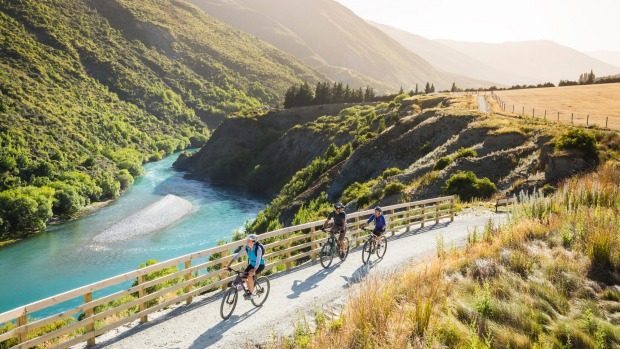
SPONSORED ARTICLE
It all began with a railway line that had fallen into disuse. The 150-kilometre section of track from Middlemarch to the town of Clyde in Otago, New Zealand's southernmost province, had outlived the industry around it, and was no longer of any use.
However, a few bright sparks saw a future for that old railway line, and while they were happy to tear up the rails and sleepers, the path itself was left intact – and that path would soon become New Zealand's most popular cycling track: the Otago Central Rail Trail.
The success of that trail was almost immediate, timed perfectly to coincide with a worldwide rise in popularity for cycling, and it went on to spark a revolution on two wheels in New Zealand. That revolution has now culminated in the creation of a nationwide network of bike trails known as the New Zealand Cycle Trail.
"In 2009, our Prime Minister, John Key, proposed the idea of building a cycling route to run the length of New Zealand, 'from Kaitaia to Bluff', at a national job summit held by the government," says Jenny Ryan, a keen cyclist and owner of Hawke's Bay cycle touring company Takaro Trails. "Although the original idea of a direct route was abandoned in favour of linking a network of existing paths and new sections, the project has been outstandingly popular."
New Zealand has long been known for its network of Great Walks, a series of multi-day hikes through some of the most spectacular scenery in the country, and the idea was that a network of Great Rides would have as much appeal for cyclists as the former has had for walking enthusiasts from around the world. More than NZ$80 million ($75m) was then poured into developing the New Zealand Cycle Trail, a network of bike tracks that covers a total of over 2700 kilometres, and ranges from gentle, single-day rides to multi-day options as well as mountain-bike trips that are for experienced riders only.
"The Great Rides are all graded from one to four, with grade 1 trails being the easiest and grade 4 being for advanced riders," Jenny says. "The Hawkes Bay Trails, for example, are all grade 1, so they have wide appeal and are especially attractive to families, seniors and those looking for a moderately active holiday with lots of opportunity to enjoy the other attractions the region offers."
The other trails offer a variety of styles and grades. The original bike track, the Otago Central Rail Trail, is a mix of grades 1 and 2, and can be ridden over five days. The newly opened Queen Charlotte Track, meanwhile, near the Marlborough region, has grades 3 and 4, while the Timber Trail on the North Island is a mix of grades 2 and 3. Each Great Ride offers something different, whether it's mountainous terrain, cityscapes, wineries, coastal views or forest outlooks, and all are dotted with rest huts, campsites, hotels, and sometimes lodges for more comfortable overnight stays.
"The trail facilities vary across the country, based on the maturity of the individual trail," Jenny says. "Here in Hawke's Bay we now have bike hire and cycle tour operators catering to all client types, from independent cyclists to those preferring fully guided or packaged experiences.
"There are also plenty of cafes, wineries and accommodation providers targeting cyclists and increasing numbers of toilet blocks, drinking fountains, sheltered rest areas and information boards around various parts of the Hawke's Bay trails."
In some ways, this has been a case of "if you build it, they will come". Tourists who were interested in cycling used to only make up 2 per cent of those coming to visit New Zealand, though they always tended to stay longer in the country, and spend more money. Now, with the increased popularity of cycling coupled with the introduction of the New Zealand Cycle Trail, visitor numbers are booming.
"In 2013, the Great Rides experienced a 56 per cent average growth rate, with an estimated 97,000 trail users recorded for the month of January 2014 alone across the network of Great Rides," says Jenny.
More than 1200 jobs were created as part of the trails' construction – however, it's those with a long-term interest in cycling in New Zealand who are experiencing the biggest windfall.
"Our company has been operating since 2009 and has seen year-on-year growth in cycle tourist numbers from both domestic and international markets over the past six years," Jenny says. "The past 12 months has seen the highest percentage growth of any year at 34 per cent, so the momentum is building as awareness of trails increases.
"In the past 12 months we've welcomed visitors from the UK, Singapore, Australia, Canada, Hong Kong, New Caledonia, USA and Switzerland to ride our multi-day tours. Many of these visitors have told us they would not have otherwise come to Hawke's Bay, or even New Zealand, if it wasn't for the cycle tourism offering, so the trails are definitely starting to impact visitor numbers in a positive way."